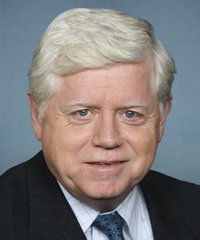
Congressman John B. Larson proudly represents Connecticut's First District. Now in his twelfth term, John sits on the influential House Ways and Means Committee—including the Subcommittee on Tax Policy and the Social Security Subcommittee, where he serves as the Chairman. Throughout his time in Congress, John has proven himself a staunch advocate for Connecticut's working families, our manufacturing and small business ecosystem, and commonsense solutions for the problems Americans face everyday.
Born and raised in the federal housing project of Mayberry Village in East Hartford, John is fond of saying he is the product of public housing, public education, and public service. His father, Raymond, worked for Pratt & Whitney, while his mother, Pauline, served on the Town Council. John graduated from East Hartford High School in 1967 and from Central Connecticut State University (CCSU) in 1971.
Many homeowners in parts of our state have discovered that their home foundations are crumbling due to a mineral called pyrrhotite in the concrete used to pour their homes' foundations.
Over the past few years, Representative Larson has worked side-by-side with Representative Joe Courtney (CT-02), Senator Richard Blumenthal (D-CT), Senator Chris Murphy (D-CT) and local, state, and federal stakeholders to find solutions for Connecticut homeowners affected by this terrible issue.
Congressional efforts have been focused on two areas: federalstudiesand tax relief.
Beginning in 2016, Reps. Larson and Courtney began consulting with the Internal Revenue Service (IRS) and Treasury Department staff, including then-IRS Commissioner John Koskinen, then-National Taxpayer Advocate Nina Olson,Department of Treasury Assistant Secretary for Tax Policy David Kautterand Treasury Secretary Steve Mnuchin. As a result of these meetings, on November 22, 2017, the IRS issued Rev. Proc. 2017-60
to enact a "safe harbor" for the treatment of crumbling foundation-related repair costs as a "casualty loss" deduction from a taxpayer's taxable income under Section 165 of the Internal Revenue Code.
Unfortunately, the Republican tax law passed in 2017 temporarily limits the casualty loss deduction until 2025, excluding homeowners with crumbling foundations. Under the law, only taxpayers who suffer damage related to a presidentially-declared Stafford Act disaster may deduct their property-casualty losses. In order to mitigate this change, Representatives Larson, Courtney, and Neal (MA-01) were able to obtain guidance from the IRS to extend the period of time that homeowners would have to claim crumbling foundation related repairs on their federal taxes. Under the new guidance, homeowners will now have through the end of 2020 to make qualified repairs to their home and until April 2021 to claim those repairs on an amended 2017 federal tax return.
Rep. Larson is working to pass a permanent fix for the casualty-loss provision. He joined Congressman Courtney to introduce H.R. 3251, which would repeal the temporary ban on using the casualty-loss deduction. On June 20, 2019, Rep. Larson secured Ways and Means Committee Chairman Neal's on the record commitment that the Committee would address the casualty loss issue.
Federal Action:
Working with Senators Murphy and Blumenthal (D-CT) and Representative Courtney, Rep. Larson was able to secure three federal studies as part of the federal appropriations process:
A Government Accountability Office (GAO) study to examine the financial impact of pyrrhotite in concrete home foundations. When completed, this study will provide an estimate ofthe financial toll due to crumbling foundations. The study will also examine responsive actions already taken to mitigate this impact and present any additional actions the federal government can take in order to further do so. This study was directed as part of a FY19 government appropriations law (P.L. 116-6) and is expected to be completed in the first half of 2020.
A U.S. Geological Survey to develop a map showing pyrrhotite occurrences across the United States. The results of this research will lead to a greater understanding of other areas that mayexperience crumbling foundations in the future. This study was directed as part of a FY19 government appropriations law (P.L. 116-6) and is expected to be completed in early 2020.
A National Institute of Standards and Technology (NIST) study to research the effects of the mineral pyrrhotite on concrete aggregate. NIST is the leading federal expert in cement and concrete standards and will develop a cost-effective and standard testing method for at-risk homes and other structures for the presence of the mineral pyrrhotite. The study will also result in the creation of a risk-rating scale so that homeowners, businesses, and local government have a better understanding of what quantity of pyrrhotite poses a danger to their foundations' structural integrity. These results will provide much needed information to towns and homeowners who currently have no way of accurately accessing their properties' risk of collapse and potential impact on property value. This study was funded in an FY20 government appropriations law (P.L. 116-93).